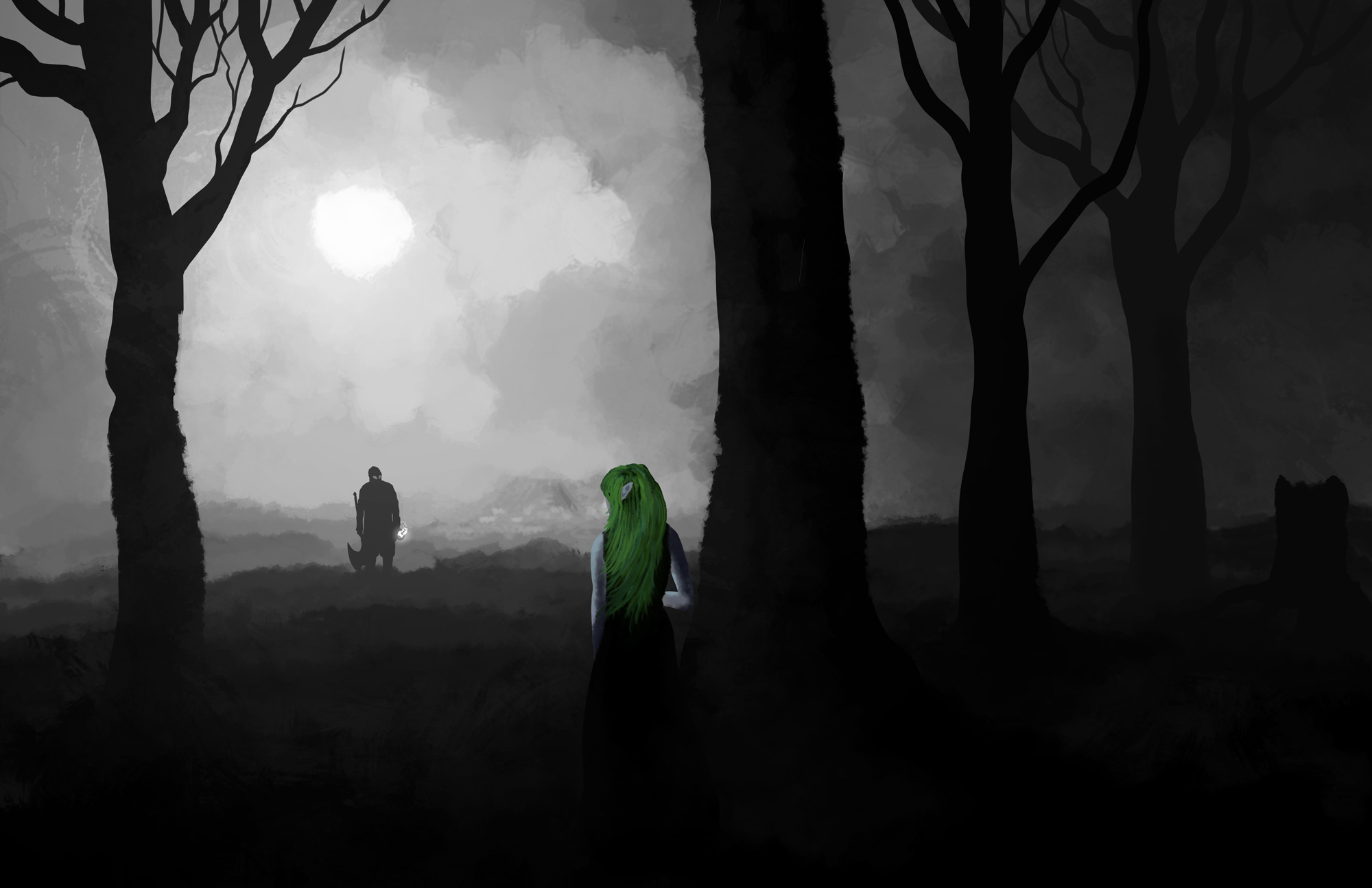What is a Role-Playing Game?
Every RPG has a section at the beginning of it explaining what a role-playing game is, and if you’re a long-time player, you might be confused why. However, dealing with new players, I’ve learned that this part is actually really important, so let’s give this a go.
Role-Playing in General/At The Table
In general, think of a role-playing game as interactive storytelling. There is one main person running the game, and instead of portraying a character, they’re portraying the entire world — if a role-playing game is a story, they’re the narrator. In some role-playing games they’re called the “Dungeon Master”, due to the tradition of Dungeons & Dragons, where the person running the game literally designs a dungeon for you to explore. Other games go with the more general “Game Master”. Huldufolk prefers “Storyteller”, given the core purpose of the game. The Storyteller helps you create your characters, and creates the story your characters interact with, and shape with your choices.
Each of the other people in the game creates a character. This character has their own merits and weaknesses, their own dreams, goals, and fears. You interact with the world of the game through your character, talking to other players at the table as your characters. Your Storyteller is portraying every other character in the world, and if you want to interact with that world, you talk to the Storyteller. Your character will find themselves in hard situations, conflicts, and moral quandaries. While your character may very well be nervous, angry, or distraught at what happens in the game, remember that the point of role-playing games is to tell a story. You might be more invested in your character than you would a character in a tv show or a movie, but all great stories involve experiencing setbacks.
If you’re playing Huldufolk at a table, your game is likely focused on the specific plots of the Storyteller’s creation, and dealing with political enemies and allies the Storyteller has created as Non-Player Characters. Your group may decide to all play on the same side, as a single faction dealing with the others, or you might play in similar but differing factions, allowing some amount of conflict at the table between player characters.
Each RPG has different focuses with its setting and system. In Huldufolk, the focus is telling a story, and so the system is narrative. You may encounter other games that instead focus on a simulationist system, where the system focuses on trying to reflect a real world understanding of combat, with consistent logic. Examples include Shadowrun, or GURPS, or Battletech. Huldufolk is instead a narrative game; instead of focusing on the details of every knife swing and gun shot that happens, Huldufolk focuses on allowing players to resolve conflict quickly, leaving the players to fill in the details of how it was resolved in the world.
Live Action Role-playing
While role-playing at a table involves a small group of 2-6 players and one Storyteller, Live Action Role-Playing games can host significantly larger groups — ranging from a table top sized 6 person game, up to hundreds of players. As a game grows larger, there’s generally a host of assistant Storytellers, who work for a Lead Storyteller.
The fundamentals of Live Action Role-Playing are similar to table top, with one main addition: instead of sitting at a table playing your character, you’re acting them out in the room, and costuming as them as well. Beyond the obvious difference of costuming and live acting, the focus of the game shifts as well: instead of a small group of players sitting around a table with an ST, the player characters are mostly interacting with each other. The Storytellers set the scene, run missions and plots around the city, and resolve mechanics conflicts between characters, but a Live Action game is far more focused on the interactions between the player characters.
While some Live Action games are physical combat oriented, with foam weapons or nerf guns for actual real world fighting, Huldufolk’s Live Action play resolves combat in the same way as the table top version does: with character sheets and playing cards. Luckily, the game’s system is light enough to work equally well at the table or walking around a Parlor LARP.
Safety and Consent
While tabletop games are played with a small group, usually with players who know each other well, often in LARP games you will be playing with people you don’t know quite as well. While at a table top game it’s generally easy enough to get a feel for everyone’s comfort levels with play, in a large LARP, additional safety mechanics are put in place to ensure a safe, welcoming, comfortable gaming experience.
Make sure to pay attention to your Storytellers, and the safety rules for their game.
As a baseline:
- Hold up crossed fingers to signal you are speaking Out of Character. This lets the other players know you are speaking as yourself, not as your character, and allows you to ask questions or otherwise get important Out of Character information across. Once you’re done, you can put your fingers down and fall back into Role-Play
- The Parlor LARP style of Live Action Role-Play requires consensual touch. Ask out of character before physically touching any other character. You should not grab, hug, shake hands, or any other physical contact, without asking for the player’s out of character consent.
- Your game should establish some form of Out of Character Check-In, to check if a player is OK with a scene or action as it’s playing out. The most common version, and the recommended one, is the OK Check-In. Be sure to play attention to your LARP Organizers for all of the safety mechanics implemented in their games.
- Know who to talk to if you’re uncomfortable in game. Often this is the Storyteller themselves, but some games may have a player representative or a similar office responsible for helping uncomfortable players. The LARP’s organizers should make this designated person clear.
- The safety and comfort of people is more important than a game. Intense role-play is a great experience, but only when everyone enjoys it. Be cognizant of the comfort level of your fellow players, and use the out-of-character tools your Storytellers provide to make sure we’re all happily playing together.
Networked LARP Games
Huldufolk: The Hidden People will be run as a networked Parlor LARP by Winding Path Initiative, a Parlor LARP Social Club. As part of WPI you’ll be able to play your local Huldufolk game, as well as travel to other games, play at conventions, and interact with other players between games online. Huldufolk games in WPI also benefit from a national Creative Director, working with the Huldufolk design team to run consistent stories and setting reveals across all WPI’s Huldufolk games. If you’d like to find a WPI Huldufolk game, or start one of your own, Contact Them.

